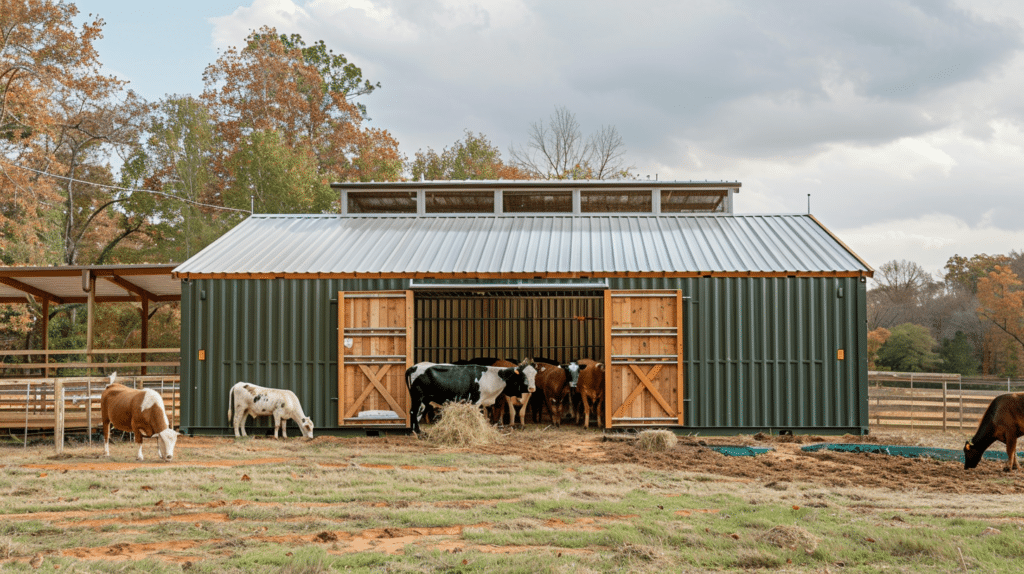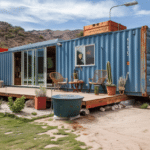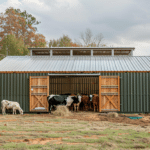Table of Contents
ToggleTransforming a Shipping Container into a Functional Barn
Innovative repurposing has become a hallmark of modern sustainability efforts, and one of the most ingenious transformations in recent years has been the conversion of shipping containers into versatile structures like barns. This article delves into the intricacies of using a shipping container as a barn, covering its various applications, benefits, drawbacks, potential upgrades, and additional considerations.
How to Use a Shipping Container as a Container Barn
Converting a shipping container into a barn involves several key steps:
- Planning and Design: Begin by envisioning the layout and purpose of your container barn. Consider factors such as the number of animals you intend to house, the types of equipment you need to store, and any additional features like a lean-to or feed storage area.
- Sourcing a Container: Acquire a shipping container suitable for your needs. Ensure it is structurally sound and free from any hazardous materials. Common sizes for container barns include 20-foot and 40-foot options, with the latter offering more space for storage and customization.
- Site Preparation: Prepare the site where you plan to install the container barn. Ensure a level foundation to support the weight of the container and any livestock or equipment it will house.
- Modification and Customization: Customize the container to meet your specific requirements. This may involve adding windows for ventilation, installing doors for access, and creating partitions for different sections such as stalls or storage areas.
- Interior Fit-Out: Equip the interior of the container barn with amenities such as lighting, insulation, and fixtures for securing equipment or feed.
- Exterior Finishing: Consider adding external features like a roof or canopy to provide additional protection from the elements, especially if you plan to use the barn for livestock.
Applications of a Shipping Container Barn
- Hay/Feed/Manure Storage: Shipping containers offer secure and weatherproof storage for hay, feed, and other agricultural supplies, protecting them from moisture, pests, and theft.
- Equipment Storage: Utilize the space within the container to store farming equipment, tools, and machinery, keeping them organized and safeguarded when not in use.
- Livestock Shelter: With appropriate modifications, shipping containers can serve as shelters for livestock such as horses, goats, or poultry. Partitioned areas within the container can create separate stalls or pens for different animals.
- Lean-To Extension: Attach a lean-to structure to the side of the container to expand its usable space. This can provide additional shelter for animals or storage for larger equipment.
Benefits of Using a Shipping Container for a Barn
- Cost-Effectiveness: Shipping containers are readily available at affordable prices, making them a cost-effective option for building a barn compared to traditional construction methods.
- Durability: Constructed from sturdy steel, shipping containers are built to withstand harsh weather conditions and offer long-lasting protection for stored items or livestock.
- Mobility: Shipping container barns can be easily transported and relocated if needed, providing flexibility for farmers or ranchers who may need to move their operations.
- Versatility: Containers can be customized and adapted to suit various agricultural purposes, offering versatility and adaptability to changing needs.
Disadvantages of Using a Shipping Container for a Barn
- Limited Insulation: Without proper insulation, shipping containers can be prone to extreme temperatures, requiring additional measures to regulate heat and cold.
- Condensation Issues: Moisture buildup inside the container can lead to condensation, potentially causing damage to stored items or creating an unhealthy environment for animals.
- Space Constraints: While containers offer a compact storage solution, they may have limited space compared to traditional barn structures, requiring careful planning to maximize usability.
Upgrades You Can Consider Including
- Insulation: Improve thermal insulation by adding spray foam or traditional insulation materials to regulate temperature and reduce energy costs.
- Ventilation: Install vents or fans to improve air circulation and reduce humidity levels inside the container, promoting better airflow for animals and stored goods.
- Security Features: Enhance security with sturdy locks, security cameras, or alarm systems to protect valuable equipment and livestock from theft or vandalism.
- Solar Power: Consider installing solar panels on the roof of the container to provide renewable energy for lighting, heating, or powering equipment.
Ideal Container Size
The ideal container size for a barn depends on the specific requirements of the farmer or rancher. While 20-foot containers offer a compact solution suitable for small-scale operations or limited storage needs, 40-foot containers provide more space and versatility for larger operations or extensive equipment storage.
Additional Considerations
- Regulatory Compliance: Ensure compliance with local building codes, zoning regulations, and agricultural standards when planning and constructing a shipping container barn.
- Maintenance: Regular maintenance is essential to ensure the longevity and functionality of the container barn. This may include inspections for rust or corrosion, cleaning, and repairs as needed.
- Accessibility: Plan for convenient access to the container barn for loading and unloading equipment, feeding animals, and performing routine maintenance tasks.
- Environmental Impact: Consider the environmental impact of using shipping containers, including their production, transportation, and eventual disposal or recycling at the end of their lifecycle.
Transforming a shipping container into a barn offers a practical and sustainable solution for agricultural storage and shelter needs. While there are certain challenges and considerations to address, the benefits of cost-effectiveness, durability, and versatility make container barns an attractive option for modern farmers and ranchers seeking innovative solutions for their operations. With careful planning, customization, and maintenance, a shipping container barn can provide years of reliable service and contribute to the efficiency and sustainability of agricultural practices.






